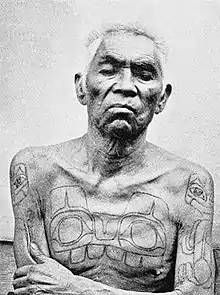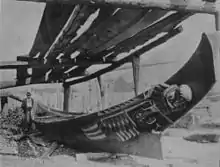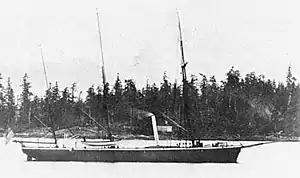Colonial police action against the people of Haida Gwaii
Various colonial police actions against the people of Haida Gwaii were undertaken since the 19th century. The indigenous peoples of Haida Gwaii often reacted violently to European and American ships which strayed near the islands. From the 18th to 19th centuries, various skirmishes took place between the Haida and European and American merchantmen and warships. Canadian settlers did not start settling the Haida Gwaii islands until 1900, and many Canadian colonial police actions were taken against resisting Haida Gwaii tribes. The indigenous Haida Gwaii population was decimated by diseases such as smallpox which were introduced by the settlers. A hostile Canadian government meant the police actions continued, which along with the continued presence of disease meant their population was reduced from tens of thousands to 588 by 1915.[1] [2]




Background
Cumshewa Haida
Cumshewa, was an important hereditary leader of the Haida people of Haida Gwaii on the North Coast of British Columbia, Canada. His name is believed to be of either Kwak'wala or Heiltsuk (Bella Bella) origin, meaning "rich at the mouth of the river". He is mentioned by Captain George Dixon who traded with him in 1787. In 1794 Cumshewa and his warriors massacred the crew of the American vessel Resolution. Cumshewa is commemorated on the map of the archipelago by Cumshewa Inlet, Cumshewa Mountain, Cumshewa Head (a point), Cumshewa Island, the Cumshewa Rocks and the modern First Nations locality of Cumshewa.
Kaigani Haida
The Kaigani Haida live north of the Canadian and US border which cuts through the Dixon Entrance on Prince of Wales Island (Tlingit: Taan) in Southeast Alaska, United States.
Kunghit Haida
The people of SG̱ang Gwaay llnagaay are sometimes referred to as the Kunghit Haida, now known as Ninstints. The Kunghit Haida occupied the southern portion of the archipelago of Haida Gwaii, with territory stretching from Lyell Island to the farthest southern tip of the archipelago. They had approximately two dozen permanent villages, as well as other smaller seasonal settlements located near major resource areas.[3] [4] SG̱ang Gwaay Llanagaay was the location of several notable episodes in the early history of European contact and trade with the Haida. At the outset of the maritime fur trade, the village was visited in 1787 by George Dixon, who noted the Haidas who met them at sea were eager to trade with sea otter fur. This marked the initially amicable trade relations, where SG̱ang Gwaay Llanagaay was visited once again in 1788 by Charles Duncan, and twice in 1789 – first by Robert Gray then by his partner John Kendrick later that year, at which point the trade relationship turned hostile.[5]
Skidegate Haida
Skidegate is a Haida community in Haida Gwaii (formerly the Queen Charlotte Islands) in British Columbia, Canada. It is located on the southeast coast of Graham Island.
Masset Haida
According to John T. Walbran the name Masset came from the Haida word Masst, or large island. Captain Douglas, on his second visit from Nootka Sound aboard the Iphigenia on June 19, 1789, named the bay leading to the inlet McIntyre's Bay. This name was used on the charts of Dixon and Meares. The American traders called the inlet, Hancock's River as shown in Ingraham's chart of 1792 after the American brig Hancock. In 1853 H.N. Knox of the Royal Navy, mate on HMS Virago, did a sketch survey of the harbour when the name Masset was adopted by the British. A survey was made in 1907 by Captain Learmouth on HMS Egeria.[6] Masset's name in the local dialect of the Haida language is Uttewas, "white slope", probably referring to a small hill south of the village.[7]
Incidents of violence between Haida and Trading ships
A list of some of the incidents of violence between the Haida and European took place since the first contact with Europeans.[8]
| Year | Ship | Ship Notes | Captain | Company | Nationality | Notes |
|---|---|---|---|---|---|---|
| 1861 | HMS Forward | Albacore-class | Royal Navy | British | In 1861 a party of Haida traders were plying their wares in Victoria when there was allegations of theft. The HMS Forward set sail and pursed the traders back to Haida Gwaii. On Cape Mudge on 17 May 1861, they caught up with the traders, and in the ensuing fight four Haida and one crewmen were killed.[9] | |
| 1853 | Virago | Steam-sloop | George Inskip | Royal Navy | British | Kunghit Haida attempt to capture the ship's two long-boats with crew on July 20 |
| 1853 | Vancouver | 184T | James Reid | HBC | British | Flounders on Rose Spit and destroyed by crew to avoid plundering by the Haida |
| 1852 | Susan Sturgis | Schooner[A 1] | Matthew Rooney | American | Susan Sturgis, which in 1852 was trading along the coast and at Skidegate was befriended by Chief Edenshaw, who joined the crew as guide and interpreter, bringing along with him some of his own men. Pulling into Masset Inlet to trade, the vessel was suddenly mass-boarded by the Masset Haida, who fought with Edenshaw and his few men who were trying to protect the crew. Word reached Chief Trader John Work at Fort Simpson in ten days and Work arrived to negotiate the release of Susan Sturgis' crew at the rate of $250 each for captain and mate, and $30 for each of the men (i.e. at the dollar equivalent in blankets). The vessel could not be saved because the Masset looted and destroyed her.[10] A year later the British ship HMS Virago came to investigate those involved but couldn't prove that anyone present at the Haida settlement had taken part in the seizure of Susan Sturgis.[10] | |
| 1851 | Georgiana | Sloop[A 2] | William Rowland | American | Founders off Cumshewa Inlet. Ship is plundered and crew and passengers held for ransom. [11] | |
| 1834 | Vanoucver | Schooner | Alexander Duncann | HBC | British | Beached on Rose Spit is plundered by Haida on March 3 |
| 1821 | Hamilton | 232T | William Martain | American | Fired into Skidegate village with the deaths of at least three Haida following the Haida's attack on the ship's shore party | |
| 1815 | Constantin | Sloop | Russian | Haida attempt to capture the vessel at Kaigani | ||
| 1806 | Vancouver | 285T | Ebenzer Clinton | American | An attempt by the Skidegate Haida to seize the vessel is foiled | |
| 1806 | Lydia | Brig[A 3] | Hill Samuel | American | Six Massett Haida are held hostage for furs and their village was fired upon for the actions of the Kaigani Haida at Kasaan a few days earlier | |
| 1802 | Hetty | Brigggs | American | Take chiefs for hostage to force trade | ||
| 1801 | Globe | Bernard Magee | American | Captain killed by the Skidgate in October | ||
| 1799 | Eliza | James Rowan | J & J. H. Perkins | American | Scotseye, a Cumshewa chief and his brother are delivered to the Kaigani for execution | |
| 1799 | Cheerful | Beck | Macao | British | Shore party is attacked with daggers and muskets killing the 2nd officer and two men at Cumshewa | |
| 1798 | Alexander | Asa Dodge | Bass et al. | American | Three of the ship's crew wounded and ten Haida killed in a skirmish at Cumshewa | |
| 1796-7 | Sea Otter | Brig | Stephen Hill | R. Sturgis, Lamb, Magee & Hill | British | Captain and two crew members killed at Cumshewa |
| 1795 | Union | Sloop 98T | John Boit | Crowell Hatcch & Caleb Gardiner | American | Attempted capture of the vessel on July 1 results in the death of 50 to 70 Kunghit Haida |
| 1795-6 | Prince William Henry | Schooner | William Wake | London or Newcastle Merchants | British | Kaigani chief held for ransom |
| 1795 | Phoenix | Barque[A 4] | Hugh Moore | British | Shore party attacked and one crew member killed at Cumshewa. In retaliation village is fired upon and village fired back. | |
| 1795 | Despatch | 160T | Elias Newbury | Dorr & Sons | American | Detained Chief Cumshewa in exchange for the one survivor from Resolution in July |
| 1794 | Ino | Sea otter fur trader ship | British | Possibly the unknown British ship who lost its masts and while trying to find new replacements was overcome and crew killed.[12] [13] | ||
| 1794 | Resolution | 90T | Robert Burling | J. & T. Lamb & Ass. | American | Captured by the Cumshewa. Only one survivor who is kept as slave |
| 1787 | Eleanora | Brig 190T | Simon Metcalfe | Metcalfe | American | Captured by the Kunghit Haida near Houston Stewart Channel with the loss of all hands, except one who was kept as a slave |
| 1793 | Amelia | Brig | Trotter | American | Crew member killed by the Kunghit Haida | |
| 1791-2 | Hancock | Brigantine | Samuel Crowell | Cravell & Creighton | American | Ship kills four Northern Haida on July 14 over a trivial issue. Wound another Haida at Langara Island. |
| 1791 | Columbia Rediviva | 212T | John Gray | American | Thre crew killed by the Kaigani Haida as revenge for the earlier "Crowell incident" | |
| 1791 | Lady Washington | 90T | John Kendrick | Burrell, Brown et al. | American | An incident relating to Captain Kendrick and Chief Xo'ya result in a skirmist where 40 Kunghit are lost. |
| 1789 | Iphigenia Nubiana | Snow 200T | William Douglas | Burrell, Brown et al | American | Near Langara Island raider attempt to seize the ship |
| 1787-89 | Princess Royal | Sloop 50T | Charles Duncan | Nootka Sound Co. | British | Cumshewa raiders try and capture the ship forcing the crew to open fire |
| 1787 | Queen Charlotte | Snow 200T | George Dixon | King Georg's Sound Co | British | After Haida attempt to steal some furs the crew opens fire but do not appear to hit anyone |
Bibliography
Notes
- A schooner is a type of sailing vessel with fore-and-aft rigged on all of 2 or more masts.
- A sloop is a sailboat with a single mast
- A brig is a sailing vessel with two square-rigged masts.
- A barque is a type of sailing vessel with three or more masts having the fore- and mainmasts rigged square and only the mizzen (the aftmost mast) rigged fore and aft.
- Trigger et al. 1996, p. 124.
- Kennedy, Bouchard & Gessler 2010.
- MacDonald 1983, p. 2.
- MacDonald 1983, pp. 4–7.
- MacDonald 1983, p. 43.
- Walbran 2014, p. 777.
- BC Names entry "Masset (Village)"
- Murray 2004, pp. 72-74.
- Belshaw 2009, p. 29.
- Lillard 1995, p. 97.
- Murray 2004, p. 50.
- McGillivray 2020, p. 90.
- Jones 2010, pp. 99-100.
References
- Belshaw, John (2009). Becoming British Columbia: A Population History. UBC Press. ISBN 9780774858694.CS1 maint: ref=harv (link) - Total pages: 300
- Jones, David E. (2010). Native North American Armor, Shields, and Fortifications. University of Texas Press. ISBN 9780292779709. - Total pages: 206
- Kennedy, Dorothy; Bouchard, Randy; Gessler, Trisha (2010). "Haida". The Canadian Encyclopedia. Retrieved May 17, 2020.CS1 maint: ref=harv (link)
- Lillard, Charles (1995). Just East of Sundown: The Queen Charlotte Islands. TouchWood Editions. ISBN 9780920663349.CS1 maint: ref=harv (link) - Total pages: 180
- MacDonald, George F. (1983). Ninstints, Haida World Heritage Site. UBC Press. ISBN 9780774801638. - Total pages: 60
- McGillivray, Brett (2020). Geography of British Columbia: People and Landscapes in Transition, 4th Edition. UBC Press. ISBN 9780774864343.CS1 maint: ref=harv (link) - Total pages: 256
- Murray, Tim (2004). The Archaeology of Contact in Settler Societies. Cambridge University Press. ISBN 9780521796828.CS1 maint: ref=harv (link) - Total pages: 269
- Trigger, Bruce G.; Washburn, Wilcomb E.; Adams, Richard E. W.; MacLeod, Murdo J.; Salomon, Frank; Schwartz, Stuart B. (1996). The Cambridge History of the Native Peoples of the Americas: North America. Cambridge University Press. ISBN 9780521573931.CS1 maint: ref=harv (link) - Total pages: 500
- Walbran, John T. (2014). British Columbia Coast Names, 1592-1906: To which are Added a Few Names in Adjacent United States Territory, Their Origin and History: with Map and Illustrations. Canadian Government Printing Bureau. ISBN 9780659098627. - Total pages: 570